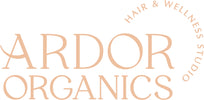No hair colour is chemical-free, despite what your hairdresser may be telling you.
More often than not, popular hair products and dyes are celebrated for removing harsh chemicals only to replace them with equally harmful ones.
Today, we’re going to explore two of the most common misconceptions in “chemical free” hair colouring – PPD-free and Ammonia-free.
PPD is not tox free
What is PPD and why is it harmful?
PPD stands for para-phenylenediamine and is petroleum-derived chemical that is a combination of aniline, benzene, naphthalene, phenols and other chemicals.
PPD is commonly used in permanent hair colours, temporary tattoos and even dark-coloured cosmetics. It is most often used to colour darker hairs as it provides long lasting hair colour that has a natural look and isn’t easily washed out.
It is a known allergen and can become even more toxic when mixed with hydrogen peroxide. Despite its efficacy in colouring hair, PPD has been known to cause skin irritations such as dermatitis, inflammation and eczema in both the client and their hairdresser.
As consumers have become more aware of the harmful connotations of PPD, manufacturers have boasted “alternatives” that are not always as kind to hair as it may sound.
What is PPD often replaced with?
If a colour says PPD free it is in most cases replaced with PTD and PTDS, otherwise known as Paratoluenediamine and para-toluenediamine sulfate.
Replacing PPD in very large amounts, both of these chemicals are properties that create tar. Yes, the black coal that we drive our cars on. If you’re seeing a trend here with industrial chemicals like tar, coal and petroleum, you’re not wrong. For decades, these products have made their way into our beauty regimes with little to no regulation.
Formulated very chemically similar to PPD, PTD and PTDS still pose risk of allergic reaction to clients and their hairdressers. In addition to the development of skin conditions and irritation, when these products are applied to our scalp, they are working their way into our bloodstream and furthermore, washed down the drain into our oceans.
Why ammonia-free doesn’t mean tox free
What is ammonia and why is it harmful?
Ammonia is used in hair colouring to effectively raise the ph. level of the hair, open the cuticle and allow the colour to enter the cortex. The larger the amount of ammonia used, the higher the ph. level will become.
When colouring your hair with ammonia, your hair experiences not only moisture and protein deficiencies but a loss of natural pigment. As a result, you need even more hair dye to offset this colour loss and the circle of harsh chemical use continues.
This, however, doesn’t solve the loss of moisture and protein loss that will require additional treatment and support to recover.
Ammonia can be mixed on its own or with hydrogen peroxide to create a lift within the hair.
Performed either way, ammonia swells the hair shaft, damages the “hinges” of our cuticles and makes it difficult to close again. With severity varying from client to client, ammonia is an unpredictable chemical to work with that creates significant damage with little colour hold.
If you can recall a time where your hair colouring experience has irritated your lungs, made it difficult to breathe or felt burning or itching post-treatment than it is likely you’ve experienced the impact of ammonia. Breathing into our bodies and irritating our skin, ammonia is frequently linked to health conditions such as asthma, eczema and hay fever.
What is ammonia often replaced with?
Did you know most colour companies that don’t use ammonia replace it very high amounts of other chemicals that respond very chemically similar to ammonia?
Ingredients to look out for include Monoethanolamide (MEA), Ethanolamine, Cocamide MEA and Aminoethyl Propanol (AMEA).
Depending on the brand, one of more of these may be mixed into your product to achieve the ammonia-like response.
What does heat have to do with it?
Whilst these chemical replacements are not ideal, if you can find a salon that is using heat within the process, you can rest assure that they are using a lower amount. The use of heat in the colouring process helps to open the cuticle where without it, the same percentages as ammonia would be required.
Organic Colour Systems solutions
To avoid all use of ammonia, Organic Colour System’s use a replacement of Soyamine and Rapeseedamide oil in conjunction with heat. Then, to give it the tiny boost the hair requires, very minimal amounts of ethanolamine is used. It features seventh on the ingredients list and thanks to our use of thermal boosting (heat), we’re able to effectively support the colour process with minimal use of harsh chemicals.
In addition to harnessing naturally derived ingredients, we utilise conditioning products post-colour to bring hair back to its optimal ph. level and calm the cuticle right now. This extra attention to your hair helps prevent your colour washing out and unnecessary hair frizz.
We do the lengthy research, so you don’t have to! Partnering with only the safest products available within the industry, you can feel confident when colouring your hair with Ardor Organics.





